
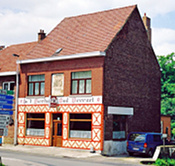
For such a small country, Belgium has an astonishingly wide range of breweries and beer styles. Add to this the fact that the number of different beers carried in many bars are often numbered in the hundreds (for example, Kulminator in Antwerpen lists over 400 beers on its menu, and the Delirium Café in Brussels lists over two thousand!) and someone new to Belgian beer can easily feel overwhelmed by the choice available. It's not for nothing that the Confederation of Belgian Brewers describes the country as "Beer Paradise."
Many people will tell you that all beers brewed on mainland Europe are lagers. They're wrong. As in Britain, the flavour-free, mass-market stuff is generally lager. But as in Britain, the interesting beers are (mostly) what we would define over here as ales, that's to say top-fermented using ale yeast. The only significant exception is lambic which is spontaneously-fermented using wild yeasts endemic to the valley of the River Zenne (Fr: Senne).
One note of caution: Belgian beers are usually much stronger than British ones. You might be used to drinking beer that's say 3.5% to 5%, but in Belgium you'll find that 5% is one of the weaker beers. 7% or 8% are common and even 10% or 11% isn't exactly rare. Fortunately you'll usually be served smaller amounts of beer than your normal pint, but do please take care.
The majority of craft brewers are to be found in Flanders and it's probably no coincidence that the Belgian equivalent of Camra (Zythos) is a Flemish-speaking organisation. Wallonia, though having fewer brewers, does still produce some fine beers.
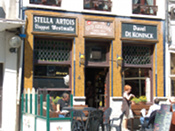
This is not intended to be an exhaustive guide to Belgian beer (but see further reading for suggestions), rather an introduction to get the first-time visitor to Belgium started on the world's most wonderful beer culture. Beermad doesn't claim any great expertise on the subject, merely a love of Belgium and its beers and a desire to introduce others to the pleasures of this wonderful country.
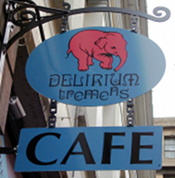
Belgium has three officially recognised languages, Flemish (almost, but not quite, identical to Dutch), spoken by 70% of the population, French, spoken by 25% and German, spoken by 5%. Although they are a generally laid-back people, Belgians (especially Walloons) can be somewhat chauvinistic where their language is concerned; using the wrong one can be taken as being very offensive. Fortunately the linguistic divide is, with the exception of the capital, pretty clearly delimited; Flemish speakers in Flanders (in the north), French speakers in Walloina (in the south) and the German speakers near the German border. Brussels is officially a bilingual city but despite being surrounded by Flemish-speaking areas and being geographically Flemish, the majority of its citizens (about 80%) speak French.This is probably the only mainland European city where using English can be justified. Indeed the two linguistic communities use English as a lingua franca rather than lower themselves to speaking the other language.
Flemings (like their Dutch cousins) tend to be adept linguists. The vast majority speak excellent English (probably better than many English people) and many also speak French, German or other languages. Walloons, by contrast are often monoglots; a fair number speak English, but Flemish-speakers are unusual.
As with anywhere else in mainland Europe, although English is widely-spoken, making the effort to at least try to speak the language is always appreciated. Beermad still remembers cringing with embarrassment in the Het Anker brewery tap when an Englishman walked in, wandered up to the bar and proclaimed loudly, "Is this the bar? You know, where you get a drink?" (just in case all those thick foreigners didn't know what a bar was). As comedian Eddy Izzard says, it's worth at least learning enough to ask politely if they speak English:
Flemish: Spreekt u graag Engels? (pron. "spray-kt oo hragh enghels")
French: Parlez vous Anglais s'il vouls plais? (pron. "Parlay voo arnglay see voo play")
Don't panic!
Most of the best Belgian beers are "bottle conditioned." This means that the beer hasn't been pasteurised and filtered before it's bottled, so it's still a living thing, not dead like, for example, Newcastle Brown. The reason for this is twofold; first pasteurising beer inevitably has a bad effect on its flavour; that's one of the reasons Real Ale tastes better than keg. Secondly, because the beer is still alive, it continues to mature in the bottle like a fine wine and can continue to change and improve for many years. This also means that a bottle conditioned beer will still taste superb many years after the pasteurised equivalent has become un-drinkable. It's not just a couple of years either. Beermad bought a bottle of Oud Beersel Geuze in 1999 which had a "best before" date on the label of 2019. (Mind you, it only lasted until about an hour into 2000!)
The natural reaction of the average British drinker is to avoid drinking any beer that isn't perfectly clear. This isn't for any really good reason, but rather because of a number of myths which have become accepted as "common sense".
Myth 2: the sediment's bad for you. If like me you enjoy eating Marmite, then you're already consuming vast amounts of beer sediment, as that delicious spread's main ingredient is yeast recovered from breweries. Indeed, far from being bad for you, there are positive benefits to consuming the yeast; it's an excellent source of many B group vitamins, especially B12 which can be lacking in the diet of vegans.
And No, it doesn't give you the runs!
So should I drink the sediment or not? Different people will find they prefer different beers with or without the sediment. Experiment a bit and see what suits your palate. There's no need to waste money buying one bottle to try without and one with, just pour about ¾ of the bottle into your glass carefully (the waiter will probably do this for you) and when you've drunk most of that, swirl the bottle to loosen the sediment and pour it in. If it turns out that you don't like it, then you haven't wasted much. If you do like it, it will have really been worthwhile.
It's worth keeping a note of which beers you prefer served with or without the sediment, then you can remember for the next time. (The Beermad mobile app for Android has a facility for doing this).
Although your tastes will no doubt be different to mine, a few of Beermad's sediment preferences amongst some favourite beers include:

Belgian drinkers are probably the most adventurous in the world when it comes to drinking different styles of beer. It's been said that the average British drinker will drink only one type of beer in a year, whereas the average Belgian drinker will drink seven different types in the same period.
As in most European countries, bland lagers, often claiming to be Pilsners, dominate the Belgian market. These will not be described here, since the discerning drinker will consider a Jupiler or Stella Artois tap to be more a warning than an enticement. There is no attempt to give an exhaustive list of beers within the various styles, but rather to make a few suggestions to start you on your way with Belgian beer. More in-depth coverage of the subject is left to authors such as Tim Webb or Chris Pollard, who have far more knowledge and than this writer. You will find such coverage in the further reading and useful links sections.
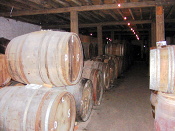
Brewed using stale hops. Fermented using wild yeasts, bacteria and a cocktail of many other (often unidentified) micro-organisms. Matured in oak barrels for maybe 3 to 5 years in dank, cobweb-ridden chambers. Frequently so sour and acidic that the first mouthful can come as a shock. Often infused with fruits.
Who but the Belgians would even think of brewing beer like this? What would a British Environmental Health Officer make of a lambic brewery?
Lambics should be totally disgusting and un-drinkable beers, but on the contrary, they make some of the most delicious, remarkable and refreshing beers you could ever drink.
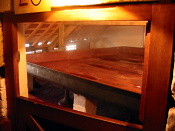
Unfortunately, the lambic designation has been badly diluted by a Royal Proclamation in 1993 which stated that any beer containing even the tiniest amount of lambic can describe itself as a lambic. (The skeptical may be unsurprised to hear that one member of the Belgian government at the time was also a director of the huge Interbrew (now InBev) beer company). This has resulted in some of the larger brewers producing lager-based beers with a small proportion of lambic in them but selling them as lambics. The only real protection is the term Oude Geuze (or Oude Gueuze) which must only be used to describe a beer containing 100% (or nearly so) pure lambic and re-fermented in the bottle.

The traditional cherry for making kriek is the Schaarbeek cherry, named after the Brussels district of that name. Sadly Schaarbeek cherries are very rare these days, so ordinary ones are generally used instead. Occasionally though, a lambic producer manages to get hold of some Schaarbeek cherries and the resulting beer is something special. Beermad was fortunate enough to sample some of the small amount of Shaarbeekse Kriekenbier that Frank Boon sent to the 2007 Brugge Beer Festival and it was truly delicious. If you see any kriek with Schaarbeek cherries in it, don't hesitate to buy some.
Lambic beers fall into four categories:
It's worth noting that some beers called krieks and frambozens (notably Liefmans) are not made with lambic, but with brown ale instead. Whilst some people (including me) enjoy these, the balance is generally nothing like as good as lambic fruit beers as they are often sweetened. However, if you ever get the chance to try unsweetened (ongezoet) versions, it's well worthwhile as in this (unfortunately rare) form, there's a lot more to taste. Yet more krieks and frambozens are produced using other (sometimes very ordinary) base beers.
Commonly available
An easy introduction
Now you've got the taste
For the initiated
If you like visiting breweries, then don't miss the Cantillon tour if you visit Brussels. The brewery's only five minutes walk from the Eurostar terminus and it can be guaranteed you've never seen a brewery like it.
Can there be a town in Britain where you can't get a glass of Hoegaarden? Probably the most readily available Belgian beer after the awful Stella Artois (which in any case is actually contract-brewed in Whitbread's factories) this beer re-established the popularity of wheat beers in Belgium; they had all but died out by the mid-seventies.

Unfortunately, Hoegaarden has been dummed-down a fair bit by InBev, who even tried (and failed) to move production to their Jupille fizz-factory in Wallonia.
You can recognise wheat beers by the fact that they're often called "blanche" (if from Wallonia) or "wit" (from Flanders.)
Perhaps the greatest service Hoegaarden has rendered is to remind the British drinker that a beer that's cloudy isn't necessarily off. The protein haze that is typical of wheat beers only disappears when they've had all the flavour filtered and pasteurised out of them.
Spices are very commonly added to Belgian wheat beers, something that would make a German brewer blanche!

Once upon a time, when drinking water wasn't to be trusted, every abbey brewed its own beer to sustain its monks and provide refreshment for visitors. Today, brewing is only carried out in a small number of monasteries, although many commercial brewers produce beers with monastic connections; some real, others imagined. Many of these beers are produced under license from the associated monastery, which receives a royalty on each bottle sold. Such is the commercial cachet of the abbey connection, a good many beers exist which, while trying to imply a monastic connection, actually have none. Indeed, many beers are named after long-defunct abbeys.
Only beer brewed under the direct supervision of Trappist monks may be designated as "Trappist" beer. There are currently seven such breweries, six in Belgium plus a single Trappist brewery in the Netherlands

An eighth Trappist "producer" appeared in 2011, associated with the Mont des Cats monastery in French Flanders. However no beer is actually brewed in France, it's actually produced at Chimay. Initial reports from those who have sampled the beers suggest they retain the Chimay "quality".
Beermad has also recently sampled beer from a new Austrian Trappist brewery, Stift Engelszell. Although showing potential, it's currently a little rough & ready.


Probably the beers that might first tempt a lager drinker to try something more interesting, indeed many of them are brewed using a lot of lager malt. These beers vary from the very light (such as Brugse Zot Blond) to the golden and powerful (such as Duvel). They tend not to be spiced and are often fairly lightly-hopped.
Beermad tends towards darker beers than these, so fewer personal recommendations here.


Red beers are a particular speciality of West Flanders. They get their colour from the dark malts used in their production. Like geuzes, red beers tend to be blends of old and young brews. To make the similarities greater, they are sour, although never so sour as the most extreme geuzes and often it is barely noticeable.
Fears that Palm's takeover of the Rodenbach brewery would lead to a reduction in quality turned out to be un-founded, as they have actually invested a lot of money into revitalising production. Though some may question the wisdom of starting to sell Rodenbach in cans or (worse still) launching the dread Redbach, described by Tim Webb as "Dilute Rodenbach mixed with Boon Kriek and sold in American bottles for youngsters".
Very much a Walloon speciality, particularly from the west of the Hainault province, these beers are less common in Flanders. As the name suggests these are seasonal beers traditionally brewed during the cooler months of the year, to be drunk during the summer. Many Saison brewers can trace their history back to traditional farmhouse breweries.
To Beermad's palate, Saisons have a rather cloying mouth-feel, rather reminiscent of Dutch Bok beers. So the only recommendations made here are of beers that others have enjoyed.
Brown ales are a particular speciality of East Flanders, but are of course brewed all over Belgium. Beers designated as Old Brown (Oud Bruin) are (or at least should be) blends of young and old beers. They are frequently quite acidic, although not as much so as lambics. Ideally, they should have a pronounced lactic overtone.
These beers are often hard to find, with the only readily-available one being Liefmans, which has undergone a revival in recent years since being taken over by Duvel Moortgat.
Some brewers infuse their brown ales with fruit in a similar manner to the lambic brewers. Although the sweet/sour balance is less pronounced, some of these are very popular.
Often designated "Special" though some, like the very readily available Palm Speciale, are pretty ordinary.
Generally bronze or copper in colour and relatively low in alcohol (relative to the average Belgian beer, that is) many of these ales were developed as a response to the encroachment of Pilsner-style lagers in the 1920s.

Despite being in most respects an admirable country, the Republic of Ireland casts a long shadow over the world of stouts. Proving the adage that "the better the advertising the worse the product", Guinness is an over-hyped, mediocre stout with an ABV of barely over 4% on which the head is more important than the body. Fortunately, Belgian stout brewers don't feel they need to follow Dublin's example. Indeed even Guinness has recognised the folly of trying to sell caramelised gnats' piss in Belgium, so they export a heavier 8.8% version from Dublin.
Belgian stouts tend to be higher in alcohol than average, are very dark and full-bodied and may be dry or sweetish.

In some ways, trying to categorise beers is a bit like trying to herd bees. You might get a few in the right place, though your right place may not be where somebody else's right place is. And there will always be lots that escape completely.
The categories used in this guide are mostly very arbitrary; probably the only ones there wouldn't be much disagreement about would be the lambics (which can only be produced in one way) and the Trappists (though there are those, Beermad included, who feel Chimay's production is now so much removed from the monks that their beers don't really deserve the Trappist designation).
Here are a few worth-trying beers that Beermad can't fit into any obvious category.

Beers bottled for export by larger breweries often have their labels in English. But smaller brewers and bottles aimed at the domestic market generally just have them in Flemish and French. A few key words and phrases are worth knowing.
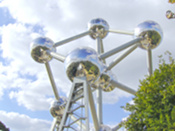
Pleasant as it is to enjoy a few bottles of Belgian beer at home, nothing can beat getting over the channel and settling in a nice bar to sample a few beers.
Despite being little-known (and often the subject of unfair derision), Belgium is a great place for a holiday. Whether your preference is for a seaside holiday, exploring the countryside or strolling round medieval cities, it's a country with something for everybody. And it's easy to get to.
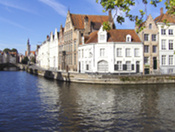
The big tourist destination is Brugge (annoyingly more often known by the English by its French name, Bruges). And it is indeed, a beautiful city, if perhaps rather "chocolate-box" and overwhelmed with tourists. For beer-lovers it's as close to heaven as can be imagined; within half a kilometre of the Markt there are probably over five hundred different beers to be found in a couple of dozen excellent bars. It seems there's hardly a month goes by without news of another new beer bar in the city.
The coastal towns and cities, such as Oostende, Knokke-Heist and Zeebrugge offer what a beach-tourist would look for, though they suffer architecturally from having been extensively bombed during the World Wars and having been rebuilt as sympathetically as was Coventry.
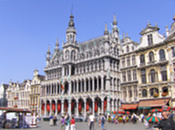
Brussels is a surprisingly enjoyable city. Like every European capital it has its share of utterly revolting modern architecture. But there are also a great number of interesting buildings to look at; from Art-Deco (such as "Old England"), futuristic (The Atomium) to the baroque (the Grand'Place/Grote Markt - quite rightly a World Heritage Site). Beermad is particularly fond of the Poechenellekelder; situated overlooking the Mannekin Pis, this ought to be the kind of bar that sells fizzy rubbish at inflated prices to tourists, but it's actually a wonderful bar with an imaginative list and friendly, efficient service.
Jazz lovers may want to take a trip to Dinant, home of Saxophone inventor Adolf Sax. It's an attractive little town with impressive views from the hilltop fortifications. It's also home to the Abbaye de Leffe; Beermad's visitors will probably prefer to avoid the beer brewed in its name
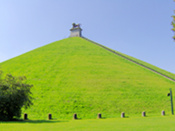
History buffs can visit the site of the Battle of Waterloo, though apart from the visitor centre and a number of memorials, there isn't actually much to see apart from a lot of attractive countryside. The battlefield isn't actually at Waterloo, it's at Braine-l'Alleud a few kilometres south. It got dubbed the Battle of Waterloo because Wellington's HQ was in a hotel (now a museum) in that town.
If you only buy one guide book for your visit to Belgium, buy Tim Webb's Good Beer Guide to Belgium (see further reading).
Visiting one of the specialist beer bars in Belgium, you'll find such a range of beers that you could be forgiven for thinking there was no point in anybody running beer festivals in the country as well. But they do. And very good they are too.
Unlike British beer festivals Belgian festivals tend to have a number of small bars, each run by one or two breweries and showcasing their beers. And often you'll even meet the brewer on his bar.
There are too many festivals to list here, but a calendar with all the information you could possibly need can be found at Filip Geerts' excellent Belgian Beer Board. Some festivals Beermad has enjoyed include:

A few of the easy ways to get from Britain to Belgium:
Visit Belgium has a useful page with a lot of information about breweries you can visit, beer festivals and much more
The most comprehensive guide to Belgian beers is probably the late Michael Jackson's Great Beers of Belgium. The only major weakness of this book is that Jackson seems reluctant to say anything negative about any beer, which suggests that his association with the Confederation of Belgian Brewers may have been a little too close for him to be regarded as a truly independent writer. Despite this, the book is highly recommended.
For "on the spot" information on drinking in Belgium, by far the best guide is Tim Webb's Good Beer Guide to Belgium which contains details of bars in every major (and many minor) town in the country, together with extensive brewery and beer listings. Tim also publishes Lambicland (with Chris "Podge" Pollard & Siobhan McGinn) which is a good guide to Lambics and the Payottenland bars in which they can be enjoyed. These and several other useful titles (such as Around Bruges in 180 Beers) are available from Books About Beer.
Classic Beer Styles: Lambic by Jean Xavier Guinard is a good read if like me you fall in love with this particular beer style.